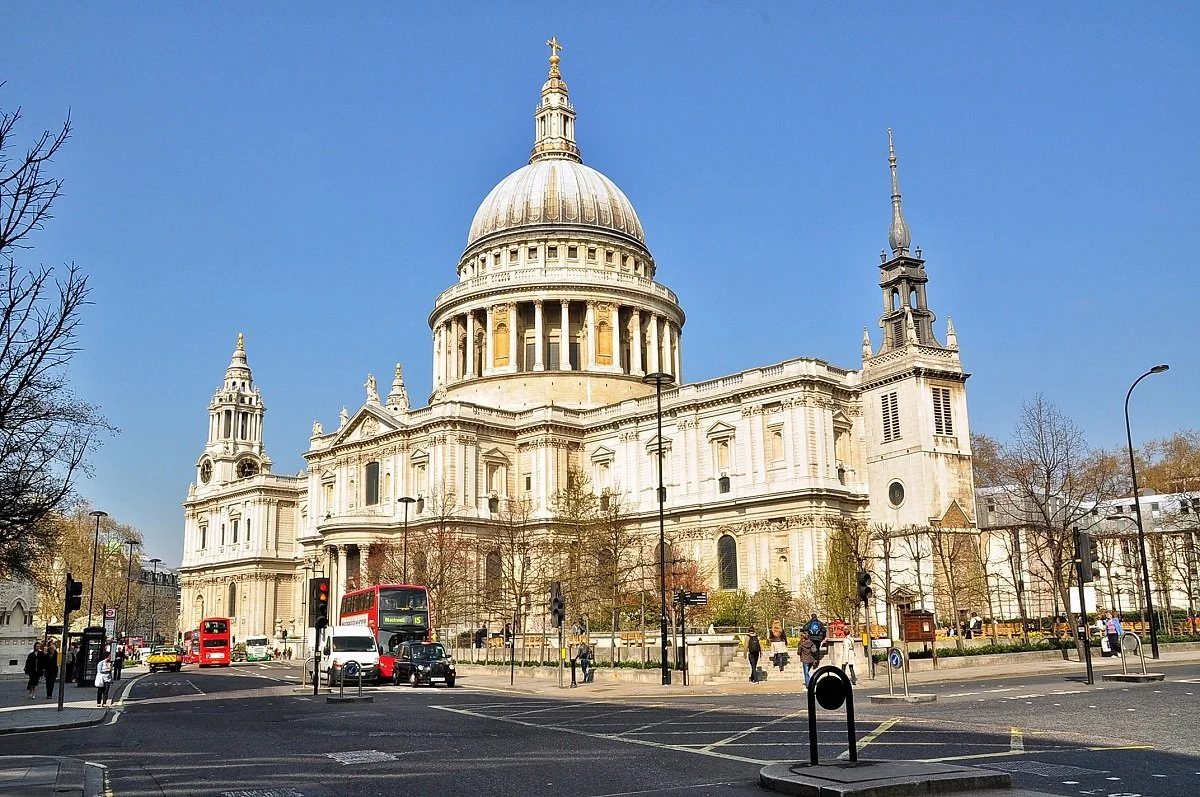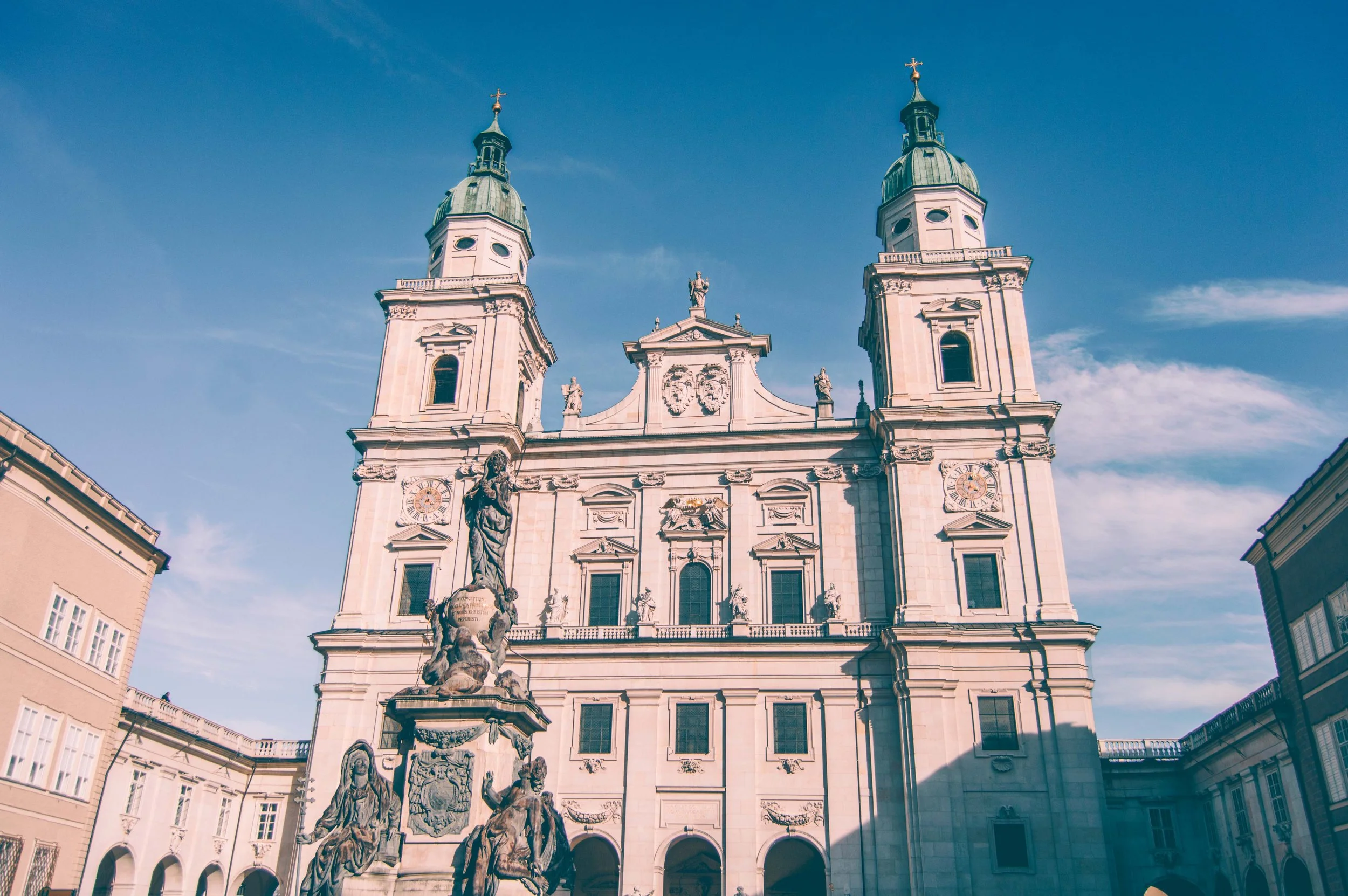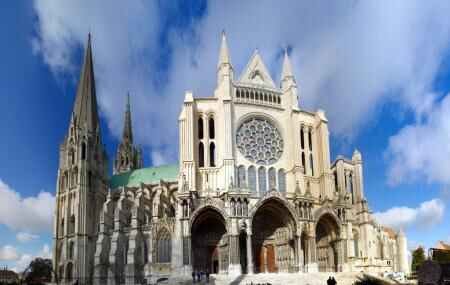Cathedrals: London and a Brief Tour of Europe
Southwark and St Paul’s
The final British cathedrals in my survey are both in London, are on either side of the River Thames, and are utterly different from each other. Southwark Cathedral, beside London Bridge on the South Bank, is little known, while St Paul’s Cathedral in the City of London is perhaps the most famous landmark in the capital.
The earliest recorded building on the site of Southwark Cathedral was a Collegiate Church, mentioned in the Domesday Book, under the control of William the Conqueror’s brother, Odo of Bayeux. In 1106 it became the church of an Augustinian Priory, and was rebuilt between 1220 and 1420, in Gothic style. After the Dissolution of the Monasteries, it became a parish church, and, in the 19th century, its bad state necessitated the demolition and rebuilding of the nave, in a style similar to the original 13th century nave. When the Diocese of Southwark was created in 1905, the parish church became a cathedral, and so, this little building is now one of London’s cathedrals! I have never sung in it, but its story is quite interesting, and it is nice to have something on a smaller scale than most in the capital city.
On the other hand, St Paul’s Cathedral is one of the world’s great churches. On Ludgate Hill, at the highest point of the City of London, there has been a church dedicated to St Paul since 604 AD. Old St Paul’s Cathedral was consecrated in 1240 and was the second longest church in Christendom with the third highest spire. As the seat of the Bishop of London, it was a very important church in the country, and dominated the city. Looking down on the Tower of London from Ludgate Hill, it was clear that the two buildings represented temporal and spiritual power.
Destroyed in the Great Fire of London in 1666, it was decided immediately to build an even more magnificent edifice on the site. Sir Christopher Wren, the pre-eminent architect of the day, had already been looking at repairing the old church before the fire, and, in 1669, he was officially appointed to design a replacement. What a design! Consecrated in 1697, and officially declared finished in 1711, the new Cathedral was easily the largest church in Britain (now overtaken by Liverpool) with one of the finest domes in the world. Indeed, the dome still dominates the skyline of the City of London, despite all the skyscrapers of the 20th and 21st centuries, and to pass by at ground level, one is overwhelmed by the magnificence of the structure. The building was financed by a tax on coal and is one of the wonders of the world.
It survived two aborted bombings by members of the suffragette movement in 1913 and 1914 and escaped largely unscathed from the Blitz of the Luftwaffe in World War II. It has seen the funerals of Nelson, Wellington and Churchill, and, in 1981, the wedding of Prince Charles and Diana Spencer. It saw the funeral of Margaret Thatcher, when my dear friend Sir Roger Gifford, who sadly died in 2021, as Lord Mayor of London nearly, accidentally, decapitated the Queen on the steps with his ornamental sword! It was never really near her, but the foreshortening of the TV camera made it look more dangerous, and you can see the Queen and the Duke of Edinburgh giggling just afterwards.
St Paul’s Cathedral
The interior of St Paul’s is as splendid as the exterior, with unimaginably high ceilings and the vast space of the dome. I sang in a performance of Beethoven’s 9th Symphony in St Paul’s, which was one of the great concerts of my career. Actually, the echo is such that much of the detail in the music was lost, but to be able to sing that great opening recitative, “O Freunde, nicht diese Töne!” was a real privilege. To hear my voice rolling round that wonderful dome was a magical moment. A few years later, at the memorial concert for my fine colleague, Sir Richard Hickox, the orchestra played Vaughan Williams’ ‘Fantasia on a Theme of Thomas Tallis’, which sounded absolutely ethereal in that space.
I have reached the end of my survey of cathedrals, under the dome of St Paul’s. I always write in my biographies for concert and opera programmes, that I have sung in most of Britain’s cathedrals, and this series of articles was designed to make that bold statement seem more real. I have missed a few but I have been lucky enough to appear in a goodly number of them, and what wonderful buildings they are. As I have said, I am not a believer, and I find the idea of a heavenly father overseeing our lives irrational and incredible. However, through the centuries, this idea has shaped the thoughts and creative powers of mankind to produce remarkable works of art, be they painting, music, literature or architecture. These great cathedrals I have written about, many dating from hundreds of years ago, stand out as an extraordinary testament to man’s astonishing creativity, and also to the power of the Christian ideal. We often complain that religion has produced more bloodshed and torment than any other cause, but we must also recognise that it is the excesses of religion, and the unnecessary rivalries of religion, that have caused the trouble. The message of Jesus, and the New Testament in general, is a warm and loving one, and you don’t have to believe in the Virgin Birth or the Resurrection to recognise that the Christian ideal – love thy neighbour, turn the other cheek, do not kill, be compassionate – is a good way of living. That these great cathedrals are testament to that ideal is the measure of their greatness.
A Brief Tour of Europe
Here endeth the sermon, and, if I may, I’d like to take you on a very short tour of some of my favourite cathedrals outside Great Britain, some in which I have sung, and others that I just love!
In contrast to my career in Britain, most of my performances in Europe have been in opera houses and concert halls. I have visited many of the great cathedrals but have sung in surprisingly few. My many performances of Arvo Pärt’s ‘Passio’ with the Hilliard Ensemble were typically in smaller churches, given the chamber work nature of the piece, although we did sing in the Grossmünster in Zürich and the Lutheran cathedral in Stockholm, both of those with the composer present. Since opera houses tend to be situated in big urban settings, I have been able to visit many of Europe’s greatest cathedrals as a tourist, for example Notre Dame in Paris, Milan Cathedral, St Peter’s in Rome, the cathedral in Lyon and the mighty Cologne Cathedral.. A surprisingly fine cathedral, which I sang in with the English Concert, was Palma Cathedral in Mallorca. Designed in the Catalan Gothic style, with northern European influences, it was begun in 1229 but not finished until 1601 and is a remarkably grand place. We sang Mozart and Haydn there, and I remember being most impressed. In fact, Palma is a lovely town, far removed from the ‘sun and sangria’ image of the island.
To find great cathedrals in which I have sung, we need to go back nearly 50 years to my university days, to the Renaissance Group I flagged up at the beginning of this series of articles. Every Easter holiday, the group would go on tour, one year to Europe and one year to the British Isles. In my time at St Andrews, we toured to Germany and Austria, England’s west country, France and Spain and Ireland. The highlight of the Austrian trip was my first visit to Salzburg in 1974. Unlike my return in 1991 with the prestigious English Concert and Barbara Bonney, we stayed on the first trip in a youth hostel and became familiar sights in our red academic gowns. We stayed a few days in Salzburg and sang in many of its magnificent baroque churches, including the marvellous cathedral. Founded in 774, it was built and rebuilt several times until the present building was finished in 1628. It is a monumental church in the Italian baroque style, lavishly decorated in a way somewhat alien to Scottish Presbyterian eyes, with many galleries. It has the most enormous echo. We counted nearly 10 seconds for the sound to stop reverberating, which made singing tricky, but which was extremely effective with contemplative Renaissance polyphony. One of the other churches in Salzburg where we sang was the Franciscan Church (Franziskanerkirche), consecrated in 1221 in Romanesque style but with the addition in the 15th century of a graceful Gothic choir. This church was the source of a famous Renaissance Group legend. Two of our students got lost in the ancient streets of Salzburg and had to ask a local the way to the church. Unfortunately, these students were not language scholars and instead of asking the way to the Franziskanerkirche, they asked for the ‘französich Kirsch’. The local was bemused, as he had been asked the way to the French Cherry! Later on that tour, we sang in the glorious Melk Abbey, an even more ostentatious church, overlooking the River Danube near Vienna. Another reverberant acoustic was found, and there is a very scratchy sounding recording of me singing the introit to a motet, “Out of the Deep have I called on thee”, which starts on a low G. Unfortunately, with the long echo, my pitch began to waver, until I found myself at least half a tone flat. An early lesson in keeping in tune!
Salzburg Cathedral
One of the great Renaissance Group experiences was the chance to sing some music by Gabrieli in St Mark’s Cathedral in Venice. This was after I had graduated and had begun to be a professional singer. I was singing in Rome at the time, and I managed to zoom up to Venice for a few days to join the choir, who were on an Italian tour. They were all, as was our wont, sleeping on some church hall floor, but, by this time, I wasn’t up for that and stayed in a hotel. Somehow, Douglas Gifford, our director, had persuaded the authorities that we were a visiting professional choir from Scotland, and we managed to get 30 minutes to sing in St Mark’s, one of the most famous churches in the world. To be able to sing works by Giovanni Gabrieli, the master of late Renaissance/early baroque music, in the building for which they were written, was a treat and we had a great time exploiting the amazing acoustic.
My final foreign tour as an undergraduate was to France and Spain, in 1976, and it was a wonderful trip. For many of us, the highlight was Seville, whose cathedral is the world’s largest Gothic church as well as simply the fourth largest church anywhere! After the Reconquista in 1248, when the Muslims were evicted from Seville, the old mosque was restructured into a church. In 1434, It was decided to build a new cathedral in the Gothic style, which was completed in 1517. The belfry, the famous La Giralda, was originally the minaret of the mosque, which was extended upwards with the addition of a bell tower. In 1568, the rotating weathervane, La Giraldillo, was added, completing the landmark as we know it now. We were able to sing inside this amazing building, and later had an extraordinary experience in the ancient alleys nearby. We had all sampled the local vino and sherry, when we ran into a group of Andalucians dressed in mediaeval gear, carrying guitars. They had been playing at the inaugural dinner held for the new king Juan Carlos, who had that week replaced the dictator Franco after decades of fascist rule. We got chatting, and they serenaded us with Andalucian melodies while we sang them Scottish part songs, all the time breathing in the scent of orange blossoms which were everywhere that night. We only stopped when some ancient locals started throwing oranges at us from their windows, shouting the Spanish equivalent of “Have ye no got homes tae go tae?” Sadly, I have never been back to Seville, but those few days at Easter 1976 will remain with me in memory.
Driving all the way north through Spain, we came to the French border, where the Spanish authorities made us strip the bus, looking for contraband and drugs. The old fascist regime clung on! They were particularly worried by our sgian dubhs – amused cries of “They’re not loaded, pal” were less than helpful with these unsmiling brutes, but we made it safely to France. Eventually, we got to Chartres, a little south of Paris, where I was to leave for Dijon and a term abroad. This was less than six months since Fran and I had been a couple, and parting was full of sorrow but not very sweet! At least we had a day to look around and sing in what I think is our favourite of all the cathedrals in the world. We have been back many times since, and have seen it transformed from a magnificent building with unbelievable stained glass, primarily dark blue in colour, into a still magnificent building with cleaned stain glass, bathing the whole building in a blue and red light quite beyond description.
Mostly constructed from 1194 to 1220, it is perhaps the finest Gothic cathedral ever built. Those clever Normans who had arrived in England in 1066 were just as keen on building in their own backyard, and Chartres, with its amazing flying buttresses, became a model for all future churches. The buttresses allowed the architects to build ever higher and lighter walls and vaults and permitted the creation of the wonderful windows of stained glass, which read like books of the bible for the illiterate folk of the era. The monumental sculptures above the three great doors contain some of the finest mediaeval stone carvings, and we were lucky then in 1976, and on future visits, to have the amazing English guide, Malcolm Miller, whose study of the cathedral was his life’s work, to explain the carvings, the windows and the support of the flying buttresses. He had been taking tours and lecturing at Chartres since 1958, and apparently has only recently retired. He was simply the finest guide anywhere in the world. He always asked if you have been before and tried to show a different aspect of the cathedral each time. His knowledge is encyclopaedic, and his commitment total.
Chartres Cathedral
I can’t explain how wonderful Chartres is. You will have to take my word for it and go. It will take your breath away, and all I can say is that it is my favourite cathedral. France has an abundance of great cathedrals: Notre Dame de Paris, Vézelay, Rouen, Reims, Tournus, Strasbourg, Lyon, Amiens, Laon, Metz, Bourges. The list goes on, but at the end of five articles, I must draw a halt.
I hope I have inspired you to get to know Britain’s cathedrals, and some of the wonders of Europe too. As a singer, I have been privileged to sing in many of these astonishing buildings, and to have had the opportunity to see others. As we emerge from the Covid nightmare, it seems almost more important to take in the fruits of man’s amazing creativity, to celebrate the wonders of the past, so we can improve the future. In the year when I have received my state pension for the first time, it is perhaps easy to come over all elegiac and nostalgic, but I feel no shame. As technology creates more possibilities and problems, this is perhaps rather a good time to reflect on the past, and where better than in the cool aisles of a great cathedral.


